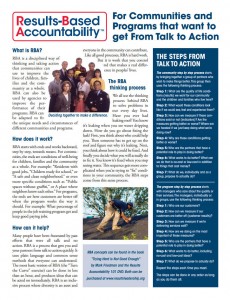All the basic ideas on two just pages. The answers to all these questions and more:
- What is RBA?
- How does it work?
- How can it help?
- The RBA thinking process
- Why is common language important?
- Where has RBA worked?
- What else do you need to get started?
- Where can you get more information?
In a concise one page document that can be printed and distributed.
Click here to download the PDF version: RBA-Brochure-2.0
Results-Based Accountability
What is it? Why do it?
Why bother with Results-Based Accountability?
Because trying hard is not good enough. We need to be able to show results to taxpayers and voters.
It provides a way to communicate with taxpayers and voters in plain English (plain Spanish, Japanese, Korean etc.).
Results are conditions of well-being stated in plain language, that taxpayers and voters can understand and recognize as important. They include things like “a prosperous economy,” “a clean environment,” “a safe community,” “healthy children and adults,” “children ready for and succeeding in school.”
Indicators are measures which quantify the achievement of results. So for example, the unemployment rate helps quantify economic prosperity, the percentage of troubled streams helps quantify a clean environment, the percentage of children reading at grade level helps quantify children succeeding in school, the teen pregnancy rate helps quantify children “staying out of trouble.” Indicators can be used to create a report card on well-being for a geographic area (state, county, city, school district, community) like the Casey Foundation Kids Count report. (Click here for other places that have produced report cards.)
It provides a way to get from talk to action across agencies and across communities.
It is a disciplined business-like thinking process where we start with the ends we want (results and indicators) and works backward to the means to get there. We establish indicator baselines showing where we’ve been and where we’re headed if we stay on our current course. Then we consider the story behind the baselines (e.g. the causes of teen pregnancy or poor water quality.) Next we consider all the potential partners who can contribute to making the numbers better. Then we consider what works to do better than baseline, including what the research tells us and what our common sense tells us. Finally, we craft an action strategy that includes no-cost and low-cost actions over a multi-year period.
The process can harness the power of the community to improve conditions. It can help community partnerships bring public and private sectors together to turn around conditions that are “not OK;” And it sometimes requires not much more than a little glue money for convening these groups, and supporting elements of their action plan.
With this thinking process we can use results to drive budgets; develop cross agency plans to turn around specific conditions of well-being, and tap the contributions of public and private sector partners and the power of no-cost low-cost actions. We can use this process to inform budget choices over several years. And when one action plan works to improve conditions of well-being, it can set the pattern to tackle another. Over time we can build up the capacity to view progress across agencies on many different results.
And it provides a way to hold programs, agencies and service systems accountable for performance.
We must avoid the thousand-pages-of-useless-paper versions of performance measurement. We must insist that programs and agencies identify the 3 or 4 most important measures;. make sure these measures focus on customer results, not just amount of effort; create baselines for these measures, and hold agencies accountable for making progress against their baselines. We can use these measures in a simple day-to-day management process that builds data-based decision making into the culture of the organizations, and periodically produces what’s needed for the budget.

